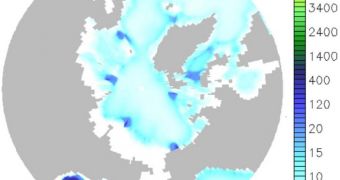Climate scientists know that methane is the most powerful greenhouse gas in the world, and as such keep it under close monitoring. A recent study has unfortunately revealed the effects that the gas' release could have on the atmosphere and the global climate.
According to investigators, there are several million tons of the chemical frozen in layers of sediment covering the bottom of the Arctic Ocean. In the near future, the substance could make its way to the surface, causing widespread damage.
The two-part study that recently concluded paints the most complete picture of how rising temperatures today are influencing the methane reserves stored under the waters. The data could therefore be used in plans aimed at mitigating the effects of global warming.
The work was carried out by experts from the Lawrence Berkeley National Laboratory (Berkeley Lab) and the Los Alamos National Laboratory (LANL), both of which are managed by the US Department of Energy (DOE).
In the first part of the research, experts looked at how higher temperatures would impact buried deposits of compounds encasing methane molecules. These chemicals, called clathrates, were found to break up easily as soon as they are subjected to warmer ocean temperatures.
During the second part, the team managed to determine that this would cause the methane to be released from its “prison,” and that it will start seeping into the ocean waters above.
Eventually, as more and more of the chemical pours in the Arctic Ocean, the latter will see its ability to break up the molecules get overwhelmed. In the end, as millions of tons of methane are released, the gas will start bubbling from the ocean surface, and will get released into the atmosphere.
Excessive release of such hydrocarbons will also reduce the available supplies of oxygen, nutrients, and trace metals, which methane-consuming microbes need to carry out their sanitary activity. When this happens, nothing will block the chemical from making its way into the air.
“Our simulation found that large methane releases erode the ocean’s ability to consume methane. At this scale, resource limitations come into play,” explains researcher Matthew Reagan.
The expert, who is based at the Berkeley Lab Earth Sciences Division, is also a coauthor of the new paper detailing the findings. The work was published in a recent issue of the esteemed Journal of Geophysical Research.
“Large-scale methane releases have a greater impact than we anticipated. When this happens, microbes cannot consume all of the methane because there isn’t enough oxygen to fuel them,” the expert concludes.

 14 DAY TRIAL //
14 DAY TRIAL //